When a Scottish punk band played the Veterans Hall in Santa Cruz in March, there were howls of protest because Wattie Buchan, the lead singer of the Exploited, had a swastika tattooed on his left arm. It caused controversy in this most liberal town and some people said the show should have been canceled.
Therein lies the problem with permanent body markings. Like the lovers who have broken up with their mates after permanently inking their hearts on their sleeves, wearers are branded for life, regardless of whether their feelings have changed.
Walking around the beaches or downtown and seeing colored ink all over bodies, it’s hard to believe that tattooing was illegal in Santa Cruz from 1964 to 1986. Tattoos are on full display, literally, from head to toe and spaces like faces once reserved only for the most dangerous Japanese gang members.
There are some 30 ink shops around the county today. Santa Cruz has widely accepted tattoos among its latest trends for surfers and yoga moms alike. Since the turn of the century, new art trends and styles have been found among the average local, making tattoos more acceptable than they once were.
Local tattoo artist Keeli Sandberg has worked in and out of the county over the past 25 years and has noticed the societal shift in tattoos today.
“Back then, you would come in with an idea, and the artist would make it,” he said. “Nowadays, people usually have things on their phones that they want.”
He also noted the increasing popularity of neck and hand tattoos: “Nobody used to get that done. It was crazy back in the day.”
Traditionally, these placements were reserved for ex-convicts or tattoo artists themselves. “It trips me out seeing 20-year-olds with that today. It’s a lot more acceptable now, which is both good and bad.”
Each tattoo artist I interviewed said they wouldn’t do swastikas today and they avoid gang pieces.
“I’ve covered up many swastikas,” Keeli says. “I try not to judge them; it’s a different world in [prison].” He’s had plenty of clients come in to cover up bad or offensive body art. Coverups are typically done on a case-by-case basis, often replacing bad stick-and-poke tattoos or gang-related pieces, he says.
Laser removal, though effective, is costly—celebrity Pete Davidson reportedly spent over $200,000 to erase half of his tattoos as part of what he called a “health glow-up,” according to TMZ.
For those seeking a less expensive alternative, cover-ups provide a solution. Keeli has done several cover-ups over the years, emphasizing that nearly any tattoo can be covered if the client collaborates with the artist.
“I like doing them,” Keeli says. “People appreciate them. Not only do they get a new tattoo, but they get rid of a shitty one.”
Keeli’s passion for tattooing began in his teenage years at New Brighton Middle School, where he recalls doing stick-and-pokes beneath desks. Inspired by his war veteran grandfather, whose body was adorned with classic 20th-century art, Keeli knew early on that he wanted to be a tattoo artist. After leaving town for a while, he returned to Santa Cruz after working in Southern California and found a job as an artist in 2008. That shop was Watsonville’s first legal tattoo shop, Freedom Tattoo.
Freedom Tattoo
Geoff Wells, the owner of Freedom Tattoo, didn’t plan on being in the tattoo business, let alone having to sue the city of Watsonville to open one. Back then, Wells, a certified Harley-Davidson technician, owned a motorcycle shop, “Motor Cyco,” in Watsonville. When the economy crashed in 2007 Wells struggled to stay afloat. One day, an idea sparked for him when he realized something was missing in the community: a tattoo parlor.
Geoff wasn’t a tattoo artist but he had been building makeshift tattoo machines and getting tattooed since he was a young teen. He had several friends who were tattoo artists and already had experience as entrepreneurs but due to a city-wide ordinance that made tattooing illegal, opening a shop in Watsonville would not be easy. Fortunately for Geoff, his mother, Kathleen Wells, was a civil rights attorney. Kathleen used her resources and legal knowledge to determine whether or not this was a battle worth fighting.
“She told me we could beat the law and that’s all I needed to hear.”
From there, the two decided to pursue the case. Their battle would take a year and a half, where they fought for the First Amendment in countless court appearances and City Council meetings.
All the hard work paid off when they finally won and changed the law to allow tattooing in Watsonville.
“I couldn’t have done it without my mom.”
As soon as he could, Geoff jumped on the first spot available on Freedom Blvd in 2008, marking Watsonville’s first legal tattoo parlor.
From there, Geoff began putting together a team of amazing artists. His hand-picked crew has changed over the years, including top-notch artists like Nolan Hatton, Rudy Hooven and Keeli Sandberg, but Freedom Tattoo’s mission has remained the same: To provide quality tattoos in a customer-based shop where all are welcome.
After 10 years, Freedom Tattoo eventually moved in 2018, becoming the first shop in Aptos. After 17 years in business, Freedom Tattoo was awarded Best Tattoo Parlor in Santa Cruz County with a silver medal for Best Piercing Studio from Good Times magazine.
Geoff praised his crew for the win and said, “It’s a true testament to the talent of our crew and the loyalty of our amazing clientele. Real customer service works. When people are treated right and walk away with a great tattoo they come back.” Today, Geoff still does motorcycle mechanics as a hobby, but his number one priority is continuing the legacy of Freedom Tattoo.
The shop is committed to growing apprentices into artists. Reyna Segura Gallardo is a tattoo artist brought in by Geoff in 2022 as an apprentice. Before starting her career, Reyna tattooed out of her garage as a side hustle. After finishing her apprenticeship, she is now a resident artist specializing in Chicano fine line art.
Chicano fine line art typically reflects a culturally rich style that emerged from the Mexican-American communities of California, particularly during the 1970s. Originating as a single-needle practice in prisons, Chicano Fine Line evolved into a celebrated art form known for its precision, symbolism and emotional depth.
Reyna considers herself lucky to be accepted by the shop and continues to learn new techniques and styles.
Abraham GarduNo (a.k.a. A-bomb) shared a similar beginning in tattooing. Before his start at Freedom in 2020, his passion began after purchasing a tattoo machine from Amazon. After doing art on his friends for fun, word went around his community that he was doing tattoos. A-bomb had expanded his work to a side hustle. After a few years an artist named Rooster at Freedom Tattoo offered to take A-bomb under his wing as an apprentice. Now he is a full-time artist specializing in black & grey and traditional tattoos.
Lights Out Tattoo
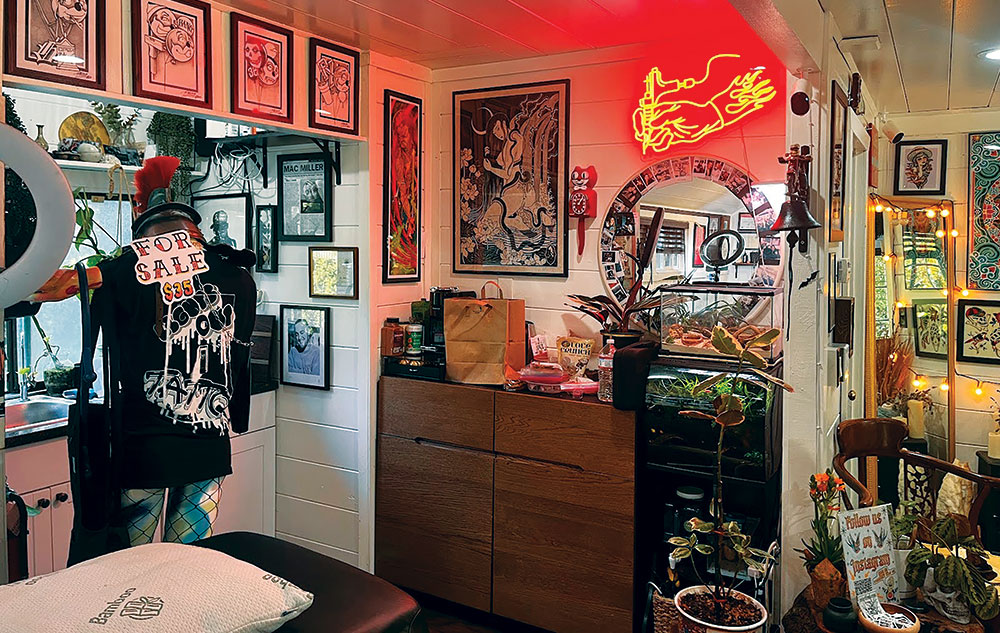
Because fineline is so popular today, shops such as “Lights Out” in Aptos specialize in it and have loyal clientele to back their work. The shop also specializes in blackwork, realism, illustrative, and surrealism, “but we can handle anything that comes in the door.”
The owners, Drew Nelson, and Domonique Nevarez, took an educated approach to their work. Both art graduates, Drew at UCSC and Domonique at Azusa Pacific in LA, met at Triton Tattoo shortly after graduating.
The two eventually left the shop to run their joint.
“Many artists (in general) don’t have a good way to make a living here,” said Drew. “I think tattooing is a great way to make a living in Santa Cruz.”
Dominique mentioned the discouragement of other shop owners and friends, suggesting there were already enough shops in town.
“But we wanted to do it anyway,” Dominique said. “We had our clientele follow us and back us up.”
“Clientele go to shops not for the place but for the artist; we were lucky to have that,” Drew said.
The opening of Lights Out in 2021 didn’t take the legal battles that the pioneer tattoo shops in Santa Cruz had. Though the shop is small, the two plan to expand next door, hoping to expand in size to combat its three-month-booked schedule.
Mission Street Tattoo
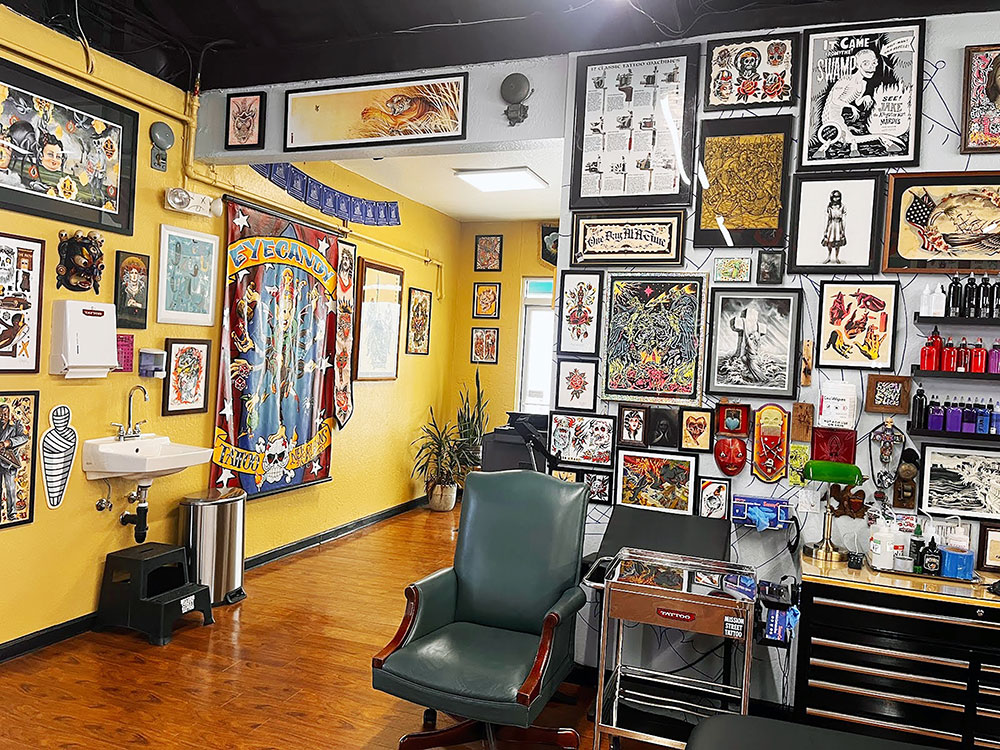
Known for its diverse artwork, Mission Street Tattoo features artists hand-selected by its owner, Ron Nelson.
Opened in January of 2014, the shop’s inauguration was a collective of four different owners, including Nelson, who formerly were artists at Staircase Tattoo (permanently closed as of this year).
When Covid-19 happened, the shop lost three of the four original owners and ceased piercings, leaving Ron as the sole owner. Despite the loss of the original crew, Nelson has maintained each artist’s independence to allow creativity to flow naturally.
Prior to scheduling an appointment to get inked, the client schedules a consultation meeting with one of the artists to collaborate on the piece that best suits the client.
“If the design is ready to go, there’s a chance that it could be done that day,” Nelson said, “But if you’re trying to do something unique or special, we set up a consultation to go over the design and set up a time.”
Ron’s background and perspective on tattoo art live on from his early days tattooing during the punk rock era in the 1990s-2000s. At the age of 15, he realized he wanted to be an artist, beginning with a homemade tattoo machine. He elaborated that “the doors were closed” in the field then, as apprenticeships were hard to come by. So, he began designing, painting, pinstriping, doing commercial art and airbrushing when he lived in Florida.
By his early 20s, Nelson had gotten his first gig at a tattoo shop and had moved to New Orleans.
Having worked in two separate regions of the United States doing tattoos, he shared that tattoos were once regional.
“You used to be able to see a tattoo and tell which part of the country it was from,” Nelson said. “Folky traditional Americana, that’s probably Brooklyn. Fine line, black and grey, that was probably Southern California. Nowadays, because of social media, I’ll see a tattoo that looks like it was done by an artist in LA, but it might have been done from someone in Italy.”
He also witnessed a change in societal rules regarding tattooing over time, suggesting that it changes more and more as each year passes. “Tattoos used to be for nonconformists and those rebelling against society,” he said.
Back then, lots of shops had rules that you shouldn’t do visual tattoos if the customer didn’t already have one. He compared that style to today.
“It’s crazy seeing what the kids get today,” he said, “but it’s normal; normal people can have tattoos, too.”
He explained that there also used to be a lot fewer tattoo artists. And, they often had a reputation for being unfriendly. He compared that to today, where a better attitude toward customer service exists.
“We welcome everyone at Mission Street Tattoo,” he said.
The shop has unique artists who specialize in their own field of work:
Pat Damlos specializes in American and Euro traditional, which is often a thinner and detailed version of American.
Kristie Crowl specializes in neo-traditional, which is a modern twist on traditional but with vivid colors and at times bold lines.
Patrick Blackstorm does black-and-grey illustrative tattoos, using black ink and shading to create a visually appealing, often detailed, and somewhat realistic designs without relying on color.
Ant Sith also does black and grey illustrative but specializes in the Japanese style.
Zion Zahir specializes in bold American traditional.
Ron intentionally designed a diverse team to allow anybody to come in and get what they want and to teach new styles of art within the shop. Overall, each artist, including Ron, can do anything he says, especially cover-ups.
From an ornate back piece to correcting for loss of pigmentation or just a needed cover-up, Mission Street Tattoo specializes in taking time to match the right artist for every client, giving them something that they will love, whether it’s their first piece or a cover-up.
An Accident Turned To Art
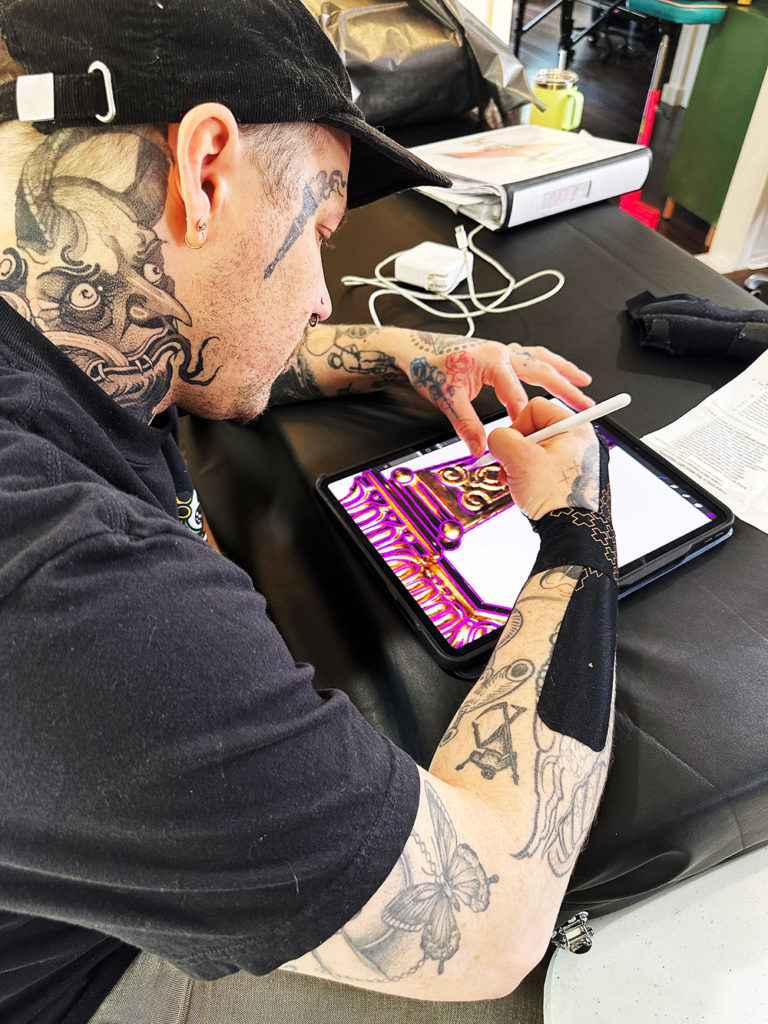
Cover-ups aren’t just for bad tattoos; some find scars or birthmarks recreated into art. Laurence Bedford, owner of the Rio Theatre on Soquel Ave., had an accident that turned into art, thanks to the help of a professional artist.
In 2000, Bedford was mauled by a spooked dog, resulting in 42 stitches on his right hand. Bedford had collaborated with an artist in tattooing a honeycomb over his scar with bees swarming up his arm.
He referred to the tattoo as a bandage over tragedy:
“Instead of watching blood come out, I had a vision of bees.”
That was his first tattoo, and since then, Bedford has had five more tattoos added to his body’s canvas. Each tattoo represents something personal that happened to him.
From rebellious roots to modern expression, tattooing in Santa Cruz has undergone a radical transformation since its legalization. What was once seen negatively is now a thriving, respected art form embraced by people from all walks of life. Pioneers artists in town helped carve out space—both legally and culturally—for today’s diverse, inclusive tattoo community. Whether used to express identity, cover up past mistakes or make trauma into art, tattoos have ingrained itself into the county’s culture. What was once deemed a “job stopper” now reflects the community itself.


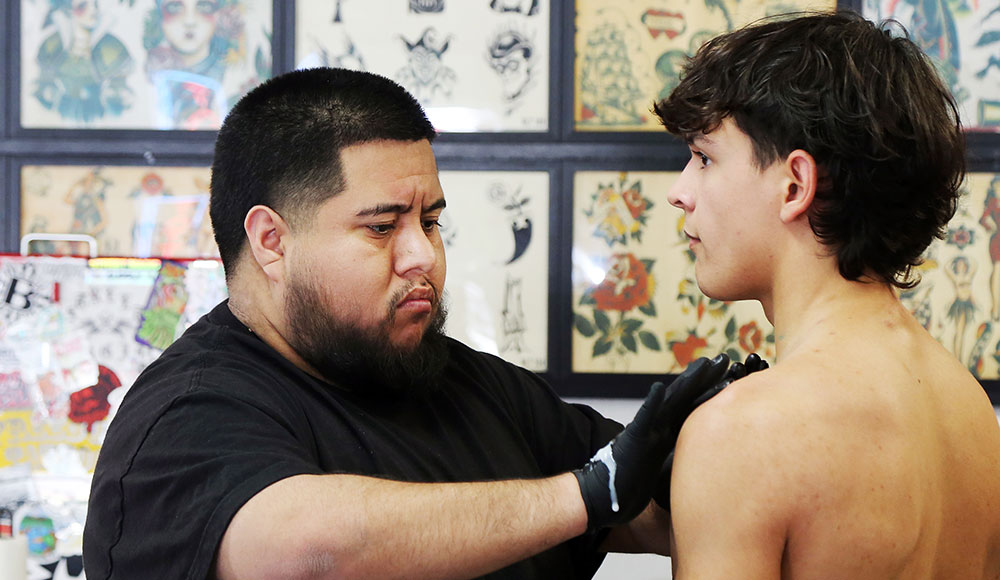


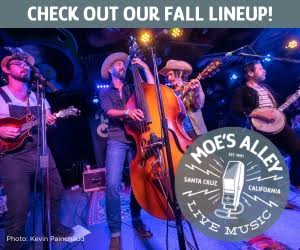








I second that. I was surprised upon finishing the article and didn’t see Klem 🙁
Typical Good Times agitprop — whenever possible, invoke White guilt!
The very first sentence in this story about tattoos references “swastikas.”
Meanwhile, Israel (the self-proclaimed “Jewish State”) continues to commit its blatant full-blown Holocaust of Palestinians.
And not a peep out of the Good Times about that!
Why not??
As if we don’t know.
A “job stopper” was what those of us from the old school called face, hand, and neck tats. Not tattoos in general.